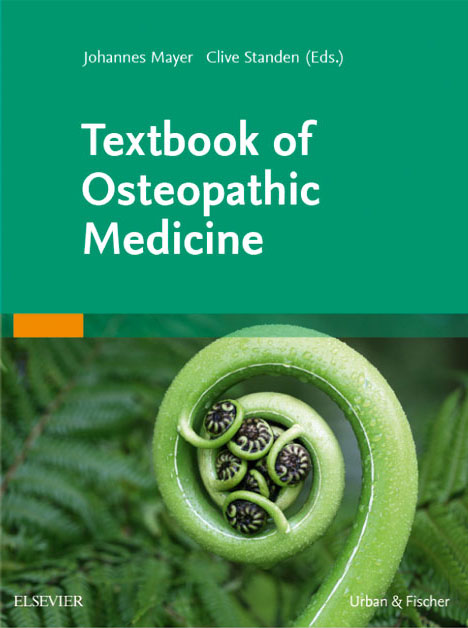Textbook of Osteopathic Medicine
500 Farbabbildungen
- ISBN: 9780702052651
- 2018, 834 pages
157,00 €
incl. VAT
plus shipping costs
Depending on the delivery address VAT may vary at checkout.
Delivery time: ca. 1 - 3 days
Description
For the first time, a 60-person team of internationally renowned editors and authors presents a textbook of osteopathic medicine that is oriented towards clinical symptoms.
Introductory chapters on history, philosophy and the spread of osteopathy are followed by a presentation of its scientific basis that clearly demonstrates how firmly osteopathy is rooted in science.
Further chapters cover osteopathic research, diagnosis and principles of treatment.
Two parts on therapeutic strategies in osteopathic practice form the core of this book.
The first is divided into regions of the body, the second into clinical specialties that offer opportunities for osteopathic treatment. In both clinical parts, osteopathic therapy is presented in the entirety in which it is actually practiced – without the common but artificial separation of parietal, visceral and craniosacral treatment.
First, the clinical symptom is explained from a medical perspective, then the osteopathic perspective and and treatment is presented.
Thus, the title is not only suitable for conveying a profound understanding of osteopaths in training, be they doctors or non-medical practitioners, but also as a clinical reference of osteopathic medicine for everyday treatment.
contents:
I History and Philosophy of Osteopathy
1 Introduction to the history of osteopathy
2 Scientific, cultural and political contexts in the 19th century
3 Andrew Taylor Still’s development of osteopathic healthcare
4 Philosophical osteopathy
5 John Martin Littlejohn: a visionary paradox
6 Osteopathy – the first 50 years
7 The spread of osteopathy worldwide
II Scientific Basis of Osteopathy
8 The fascial system: embryology, organisation and composition
9 Basic embryology from an osteopathic Perspective
10 Central and peripheral, somatic and autonomic nervous systems
11 Mechanotransduction: from the cellular level to the whole body
12 Neurobiological principles of osteopathy
13 Social competence and mindfulness in osteopathy
14 Psychotherapy and osteopathy
15 An anthropo-ecological narrative
III Osteopathic Research
16 Osteopathic research – evolution of a research tradition
17 Statistical principles in research18 Principles of qualitative and quantitative nresearch methods
19 Principles of osteopathic treatment Evaluation
IV Diagnosis and General Osteopathic Treatment
Patient History, Examination and Diagnosis
20 The patient’s history from an osteopathic Perspective
21 The art of palpation
22 Scientific principles of palpation
23 Screening – scanning – examination
24 Primary lesion, key lesion, sequencing
25 Osteopathy: red and yellow flags
26 How to work with the anthropo- ecological narrative in clinical use
General Osteopathic Treatment
27 Principles for osteopathic treatment
28 Self-recovery processes and osteopathic care: towards a process approach
29 The history of osteopathic techniques
30 Osteopathy and exercises
31 Osteopathy and other complementary/traditional methods
32 Best practice in osteopathy and osteopathic medicine
V Clinical Management in Osteopathic Practice: Body Regions
33 Introduction: clinical management in osteopathic practice
Head and Face
34 Headaches from a neurological perspective
35 Headaches from an osteopathic perspective
36 Dizziness from a medical and osteopathic perspective
37 Mouth, jaw and facial pain from a dental Perspective
38 Facial pain from a perspective of ENT medicine
39 Temporomandibular joint and facial pain from an osteopathic perspective
Neck and Shoulder
40 Pain in the shoulders and the neck from an orthopaedic perspective
41 Pain in the shoulders and the neck from an osteopathic perspective
Upper Limbs
42 Functional and structural disorders of the upper limb from an orthopaedic perspective
43 Lemniscatic activity in upper limb tissues
The Thorax
44 Thoracic pain from an internal medicine perspective
45 Thoracic pain from an orthopaedic perspective
46 Thoracic pain from an osteopathic perspective
Pulmonary Disorders
47 Management of respiratory dysfunction
48 Pulmonary disorders from an osteopathic perspective
Abdominal Region
49 Abdominal pain from an internal medicine perspective50 Pain in the upper abdomen from an osteopathic perspective
51 Lower abdominal pain from an osteopathic perspective Lower Back
52 Lower back pain from an epidemiological perspective
53 Lower back pain from a multimodal perspective
54 Non-specifi c back pain from an osteopathic perspective
The Pelvis
55 Pain in the lesser pelvis in women from a gynaecological perspective
56 Pain in the female pelvis from an osteopathic perspective
57 Pain in the male pelvis from an osteopathic perspective
Lower Limbs
58 Functional/structural dysfunction of the lower extremities from a medical perspective
59 Lemniscatic activity in lower limb tissues
VI Clinical Management in Osteopathic Practice: Special Disciplines
Osteopathy and Paediatrics
60 Developmental disorders from aneuropaediatric perspective
61 Developmental disorders in children from an osteopathic perspective
(…) etc.
Author


